AMD’s Radeon HD 5770 & 5750: DirectX 11 for the Mainstream Crowd
by Ryan Smith on October 13, 2009 12:00 AM EST- Posted in
- GPUs
Power, Temperature, & Noise
With the 5700 series being built using TSMC’s 40nm process, and with their low target power, we should see some interesting results here.
We do need to note however that thanks to some badly timed broken hardware, we’re using our secondary test rig for noise and temperature data, so the results are not directly comparable to our 5800 series reviews. As a result we also only have power data for the 5770; we weren’t able to get power data on the 5750 in time for this article.
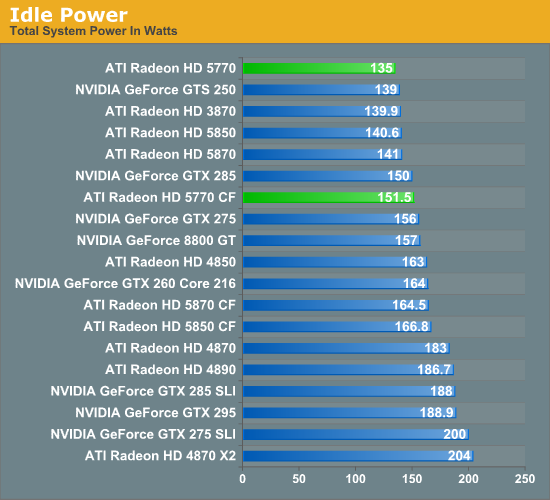
Thanks to the 40nm process and relatively simple nature of Juniper, the 5770 turns in the best idle power usage of all of our mainstream and high-end cards. At 135W it edges out the GTS 250, the 3870, and its bigger brothers the 5800 series. Coupled with a good CPU, and this should result in a system with very good idle power usage for the performance levels it provides.
We can also see the low power usage of an individual 5770 in our 5770 CF usage. There's a 16.5W difference, as the slave card gets to power down even further than 18W.

At 256W for load power, the 5770 isn’t quite the winner here like it is for idle power. The 3870 beats it by 14W at the cost of a significant degree of performance, while the 8800GT is neck-and-neck with the 4770, again with a decent-sized performance gap. Everything past here approaches 300W and beyond. As a result, even if it’s not the least power hungry card we have, it’s very close, and it’s certainly among the best for on a power-to-performance ratio.
Meanwhile looking at the Crossfire results, we see that there's a 134W difference between cards. As the Evergreen architecture allows us to go higher so long as the VRMs are safe, this appears to that situation in action.
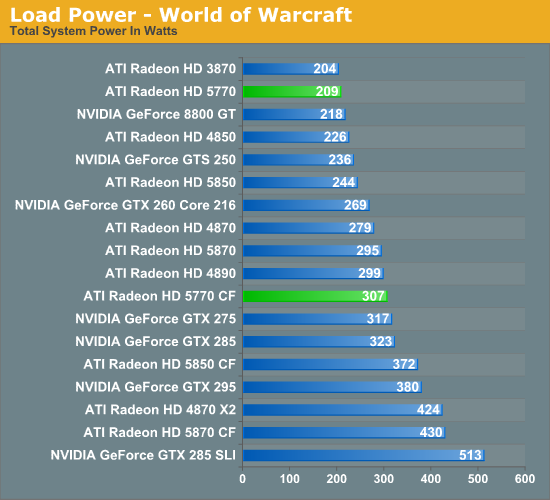
World of Warcraft gives us similar results. The 5770 still doesn’t come out on top, but its bested only by the 3870 and its significantly lower performance. The gap on the other side isn’t particularly large either, but the first card that can beat the 5770’s average gaming performance doesn’t show up until we hit the 5850.
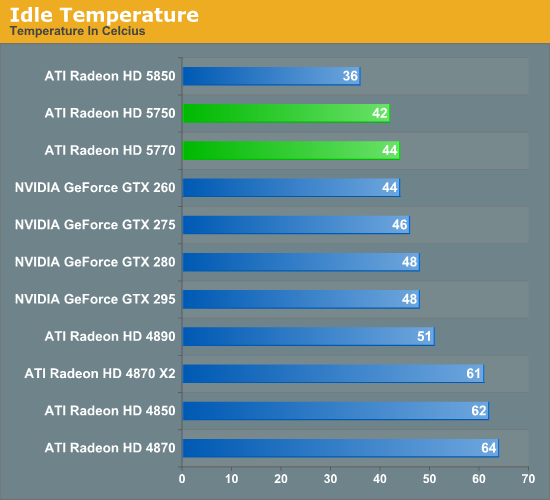
The 5700 series turns in some of our best idle temps, tying or beating everything besides a 5850. In fact we’re a bit surprised to see a 5850 win here given the lower idle power usage of the 5700 series, but the data doesn’t lie.
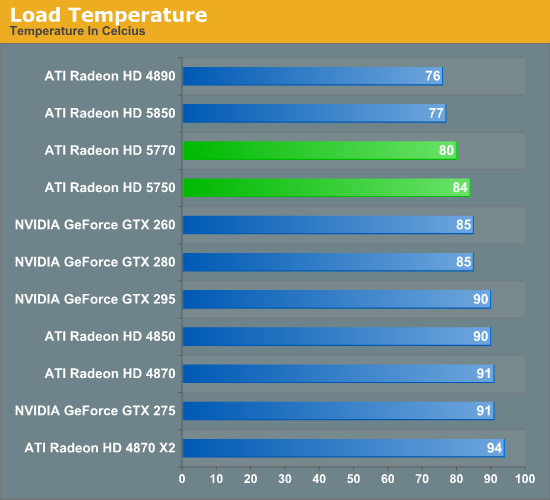
It’s load temperatures where all of the action is at. Again the 5700 series do quite well here, only losing to the 5850 and a very loud 4890. Compared to the rest of the 4800 series in particular, we’re a good 6C-11C cooler for a set of cards that offer similar to slightly less performance. Aren’t smaller manufacturing processes great?
However in spite of the 5750’s lower power consumption, it doesn’t do so well here in terms of temperature compared to the 5770, coming in 4C hotter. We’re going to chalk it up to the egg cooler being unable to match the 5770’s shrouded cooler. This of course makes the fact that the 5770’s shrouded cooler is going to eventually go away all the more meaningful, as conceivably the replacement coolers would end up being less effective.
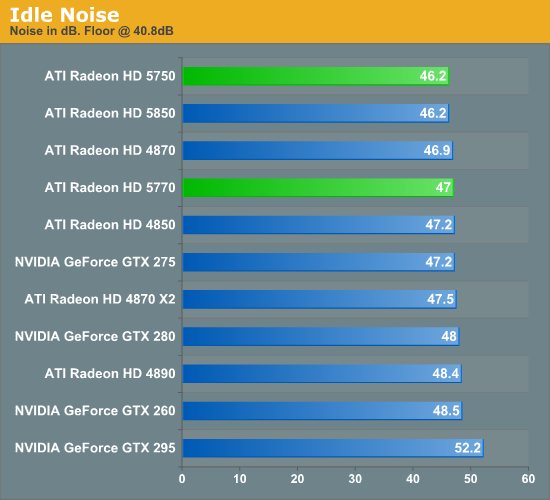
As is the case for most of the cards we test, at idle they’re virtually all the same. The 5700 series are no exception to this rule.
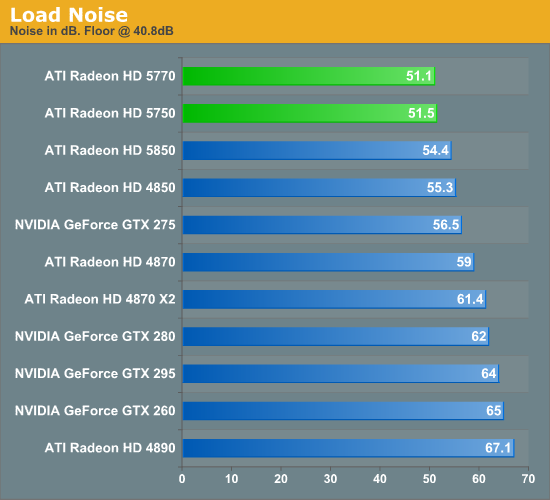
With the low power consumption of the 5700 series, their coolers don’t have to work very hard to reach their already low load temperatures. At 51dB, these are the quietest cards we’ve tested at this level of performance; we would need to drop down to something slower yet (like yesterday’s GT 220) to find something quieter.
We also can’t rule out the possibility of the 5750 going passive in the future, given its already dainty cooler. We’ve seen it done before on an 8800GT, which has a similar thermal envelope. This certainly has all the makings of the fastest passively cooled card on the market, if someone can build the right cooler.
This also leaves the door open to the idea of using the 5750 as an HTPC card. With bitstreaming audio support it’s the best HTPC card we’ve tested yet from a features standpoint, but we’re not convinced that it’s going to be the best thing out there given it’s >$100 price tag and the fact that it’s still power-hungry enough to need a PCIe power connector. In the long-term the 5600 series may be a better replacement given the same features and lower power consumption that a lower-performing part will offer, but that’s something we won’t be able to test until next year.










117 Comments
View All Comments
Mint - Tuesday, October 13, 2009 - link
The 4870 will only drop in price to clear inventory, because it's not worth it to produce them with the intent of selling them at $120 or less. I expect them to sell out before the price drops much further.Don't fret, though. The 5770 has a 128-bit bus and a fairly small die. It will drop in price soon enough, unless NVidia decides to stop bleeding $$ on its huge GT200 chips on $150 cards and Fermi-based mainstream cards can't get down in price.
samspqr - Tuesday, October 13, 2009 - link
well, my favorite retailer (alternate.de) already has the 5750 and 5770 in stock, at 130eur and 160eur respectivelythey also have the 4870-1GB at 115eur, which is MUCH cheaper
in any case, right now, with my usage pattern (24/7 on, but mostly GPU-idle, maybe just one hour a day of GPU stress), the difference in power consumption between the 4870 and the 5770 is at least 50w, which means ((50*24*365)/1000)*0.15eur/KWh = 65.7eur/year
so it pays for the difference in just over 6 months, at the expense of slightly lower performance, with the advantage of less noise
speaking of which, I like my GPUs silent, passive if possible, thankyouverymuch, so I'll wait for vendor-specific designs or after-market coolers; by the time these are out, maybe the 4870 will not eve be available anymore
samspqr - Tuesday, October 13, 2009 - link
(sorry, that was 8 months, don't know how I got that 6 the first time)7Enigma - Tuesday, October 13, 2009 - link
Search for and download GPUTool. It's still in beta and has some quirks but for massive idle power drop it cannot be beat (at least for my system, 4870). I simply lowered the 2D core/memory clocks (they have a low/medium/high setting, and ALL need to be the same setting or you get flickering), down to around 250MHz, and this dropped idle power consumption by a crazy amount (40-80w, can't remember exactly). Once the creator of the program releases a newer version I'm hoping some of the fan speed and voltage mod bugs get worked out. Even so, the 2 second click to lower idle speeds is incredibly handy.HTH
chrnochime - Wednesday, October 14, 2009 - link
I don't know if you've tried using ATI tray tool already, but after scourging around the web trying to figure out way to keep my XFX 4870 1GB from drawing more power than needed(e.g. when just surfing/playing video), I was able to drop the GPU clock to 400 MHz, and memory to 225 MHz. The memory draws much more power than does the GPU, so leaving GPU at 400 doesn't really make that much of a difference, compared to 250.Keep in mind that running said program in Vista is somewhat of a headache, since the driver is not signed by MS, so you need to do the work-around to get it running as startup program so the clocks drop can be initiated by the program.
makechen - Wednesday, April 14, 2010 - link
48566565rdh - Tuesday, January 4, 2011 - link
A year later, the 5770 is *cheaper* than the 4850/4870. I just purchased one for $99 from the egg. It consumes 30% less power at idle and at load than the 48xx cards.I suppose at the $160 price point, it was fine to slam this card. At the current price point, though, it is the BEST price-for-performance and performance-per-watt card out there.